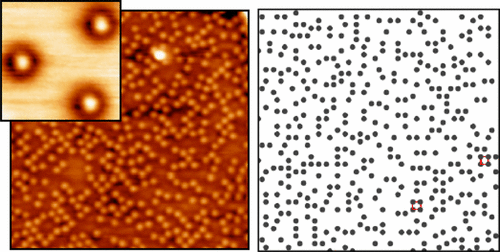当前位置:
X-MOL 学术
›
J. Phys. Chem. B
›
论文详情
Our official English website, www.x-mol.net, welcomes your feedback! (Note: you will need to create a separate account there.)
Sulfur Atoms Adsorbed on Cu(100) at Low Coverage: Characterization and Stability against Complexation
The Journal of Physical Chemistry B ( IF 3.3 ) Pub Date : 2017-09-07 00:00:00 , DOI: 10.1021/acs.jpcb.7b07046 Holly Walen 1, 2 , Da-Jiang Liu 3 , Junepyo Oh 2 , Hyun Jin Yang 2 , Peter M. Spurgeon 1 , Yousoo Kim 2 , Patricia A. Thiel 1, 3, 4
The Journal of Physical Chemistry B ( IF 3.3 ) Pub Date : 2017-09-07 00:00:00 , DOI: 10.1021/acs.jpcb.7b07046 Holly Walen 1, 2 , Da-Jiang Liu 3 , Junepyo Oh 2 , Hyun Jin Yang 2 , Peter M. Spurgeon 1 , Yousoo Kim 2 , Patricia A. Thiel 1, 3, 4
Affiliation

|
Using scanning tunneling microscopy, we characterize the size and bias-dependent shape of sulfur atoms on Cu(100) at low coverage (below 0.1 monolayers) and low temperature (quenched from 300 to 5 K). Sulfur atoms populate the Cu(100) terraces more heavily than steps at low coverage, but as coverage approaches 0.1 monolayers, close-packed step edges become fully populated, with sulfur atoms occupying sites on top of the step. Density functional theory (DFT) corroborates the preferential population of terraces at low coverage as well as the step adsorption site. In experiment, small regions with p(2 × 2)-like atomic arrangements emerge on the terraces as sulfur coverage approaches 0.1 monolayer. Using DFT, a lattice gas model has been developed, and Monte Carlo simulations based on this model have been compared with the observed terrace configurations. A model containing eight pairwise interaction energies, all repulsive, gives qualitative agreement. Experiment shows that atomic adsorbed sulfur is the only species on Cu(100) up to a coverage of 0.09 monolayers. There are no Cu–S complexes. In contrast, prior work has shown that a Cu2S3 complex forms on Cu(111) under comparable conditions. On the basis of DFT, this difference can be attributed mainly to stronger adsorption of sulfur on Cu(100) as compared with Cu(111).
中文翻译:

低覆盖率吸附在Cu(100)上的硫原子:表征和对络合的稳定性。
使用扫描隧道显微镜,我们表征了在低覆盖率(低于0.1单层)和低温(从300淬灭到5 K)下Cu(100)上硫原子的大小和偏压依赖性形状。在低覆盖率下,硫原子在Cu(100)阶跃中的分布比台阶更严重,但是当覆盖率接近0.1单层时,紧密堆积的台阶边缘变得完全填充,硫原子占据了台阶顶部的位置。密度泛函理论(DFT)证实了低覆盖率阶地的优先种群以及阶跃吸附点。在实验中,随着硫的覆盖率接近0.1单层,在梯田上出现了具有p(2×2)样原子排列的小区域。使用DFT,已开发出晶格气体模型,基于该模型的蒙特卡洛模拟和蒙特卡洛模拟已与观察到的阶地配置进行了比较。一个包含八个成对相互作用的能量的模型,都具有排斥性,给出了定性的一致性。实验表明,原子吸附的硫是Cu(100)上唯一的物种,覆盖率高达0.09单层。没有Cu-S络合物。相反,先前的研究表明,铜在相当条件下,Cu(111)上形成2 S 3络合物。基于DFT,该差异主要归因于与Cu(111)相比,硫在Cu(100)上的吸附更强。
更新日期:2017-09-07
中文翻译:

低覆盖率吸附在Cu(100)上的硫原子:表征和对络合的稳定性。
使用扫描隧道显微镜,我们表征了在低覆盖率(低于0.1单层)和低温(从300淬灭到5 K)下Cu(100)上硫原子的大小和偏压依赖性形状。在低覆盖率下,硫原子在Cu(100)阶跃中的分布比台阶更严重,但是当覆盖率接近0.1单层时,紧密堆积的台阶边缘变得完全填充,硫原子占据了台阶顶部的位置。密度泛函理论(DFT)证实了低覆盖率阶地的优先种群以及阶跃吸附点。在实验中,随着硫的覆盖率接近0.1单层,在梯田上出现了具有p(2×2)样原子排列的小区域。使用DFT,已开发出晶格气体模型,基于该模型的蒙特卡洛模拟和蒙特卡洛模拟已与观察到的阶地配置进行了比较。一个包含八个成对相互作用的能量的模型,都具有排斥性,给出了定性的一致性。实验表明,原子吸附的硫是Cu(100)上唯一的物种,覆盖率高达0.09单层。没有Cu-S络合物。相反,先前的研究表明,铜在相当条件下,Cu(111)上形成2 S 3络合物。基于DFT,该差异主要归因于与Cu(111)相比,硫在Cu(100)上的吸附更强。



























 京公网安备 11010802027423号
京公网安备 11010802027423号